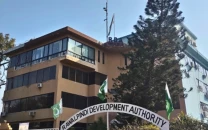Pakistan’s unregulated urban expansion
We should seriously look at how land is being used and that it doesn’t get exploited for the interest of a select few.

A more important issue, however, is how to make use of the information for better urban planning. There are two issues towards which I would like to draw some attention. The first is the inability and lack of will to regulate urban centres, and this is a huge problem. We have almost become comfortable with the sight of businesses opening in residential areas, which usually results in additional problems such as traffic congestion and related issues. There are now private colleges and even universities that operate inside four-bedroom houses. There is no regulation of the education that they impart and nor is there any check on them being set up in the first place. I remember talking to someone a few years ago, when a school had opened next door to my house in Islamabad. The explanation was that opening a school in a residential area is convenient because then the children don’t have to travel long distances. Interestingly, the school caters to children of affluent parents who could afford to drive their children around.
The second, and bigger problem pertains to the mushrooming of elite housing schemes that tend to absorb semi-urban centres and villages without any planning. No one seems to ensure how rural land is being consumed to accommodate urban sprawl. For those who argue that villagers sell their land happily because they are offered a better price must at least try to have a look at some of the inquiry reports that were done and have now been hidden away. For instance, a judicial inquiry report by the district and sessions judge Islamabad on the expansion of a particularly well-known housing developer is an eye-opener. It mentions many instances of extortion and manipulation by the authorities to procure land. In fact, urban expansion through the use of institutional force is a problem that is noticeable especially in the bigger cities. Here, I am referring in particular to the expansion of this scheme in conjunction with the DHA.
Reputed for being great projects, these indeed add to the problem of urban planning. These are gated communities for the elite, hence they have almost become autonomous of the government. Notwithstanding their efficiency, it is necessary to probe into their manner and methods of expansion. For instance, almost a year ago, an unfortunate whistle-blower from within the DHA had disclosed facts about the authority’s partnership in Rawalpindi with a well-known real estate group. There is certainly nothing wrong with that except that the scheme had encroached on land that was meant for building an alternative dam by the Punjab government to replace Rawal dam. The DHA had used its influence, which in this case is that of being an organisation backed by the military, to acquire the land on the pretext that it would build a dam. Surely, an inquiry must be conducted on how the Punjab government agreed to outsource its responsibility to a private party.
However, the DHA did not build any dam and instead used the land to develop a housing scheme. The venture was profitable as the land prices in the area fell. Since it was a known fact that the land was earmarked for a dam to be built by the government, people happily sold their land, which they would have to do anyway, to the DHA at a much lower price. Later, the DHA entered into a partnership with the development group and transferred the money and land to it with the expectation that the latter would acquire more land and complete the joint project of a housing scheme. Many years later, there is no sign of the housing scheme coming to fruition with the hard-earned money of approximately 121,000 people gone down the drain including that of 40,000 soldiers and officers.
A complaint was registered with the National Accountability Bureau, which is being thrown around its several offices and divisions with no chance of any justice in sight. The original complainant, a retired army colonel, is being forced to go silent as ‘big fish’ are involved in the case. There seems to be no justice for those who paid for the land, nor for the people of the area as this is a huge encroachment on the rights of people. A dam is a public good as its water is meant for people living in the two cities. This right cannot be sacrificed for the interest of a few.
Urban planning cannot be done for the elite alone. The presence of gated communities that are almost disconnected from the area around creates social problems. But to start with, it makes planners and policymakers go to sleep as far as meeting the needs of people are concerned. The DHAs in Lahore, Islamabad or Karachi are now so disconnected from the rest of the city that those who live there can afford to become disconnected with the reality of the rest of their city. It is probably nice not to look at glaring poverty but then the gap it creates between people results in long-term imbalances and greater injustice.
In this day and age, urban planning is a complex science. It is not just about accommodating greater numbers but about narrowing the social disparity gap so to avoid long-term complications. We should seriously look at how the land is being used and that it doesn’t get exploited for the interest of a select few.
Published in The Express Tribune, November 29th, 2012.














COMMENTS
Comments are moderated and generally will be posted if they are on-topic and not abusive.
For more information, please see our Comments FAQ